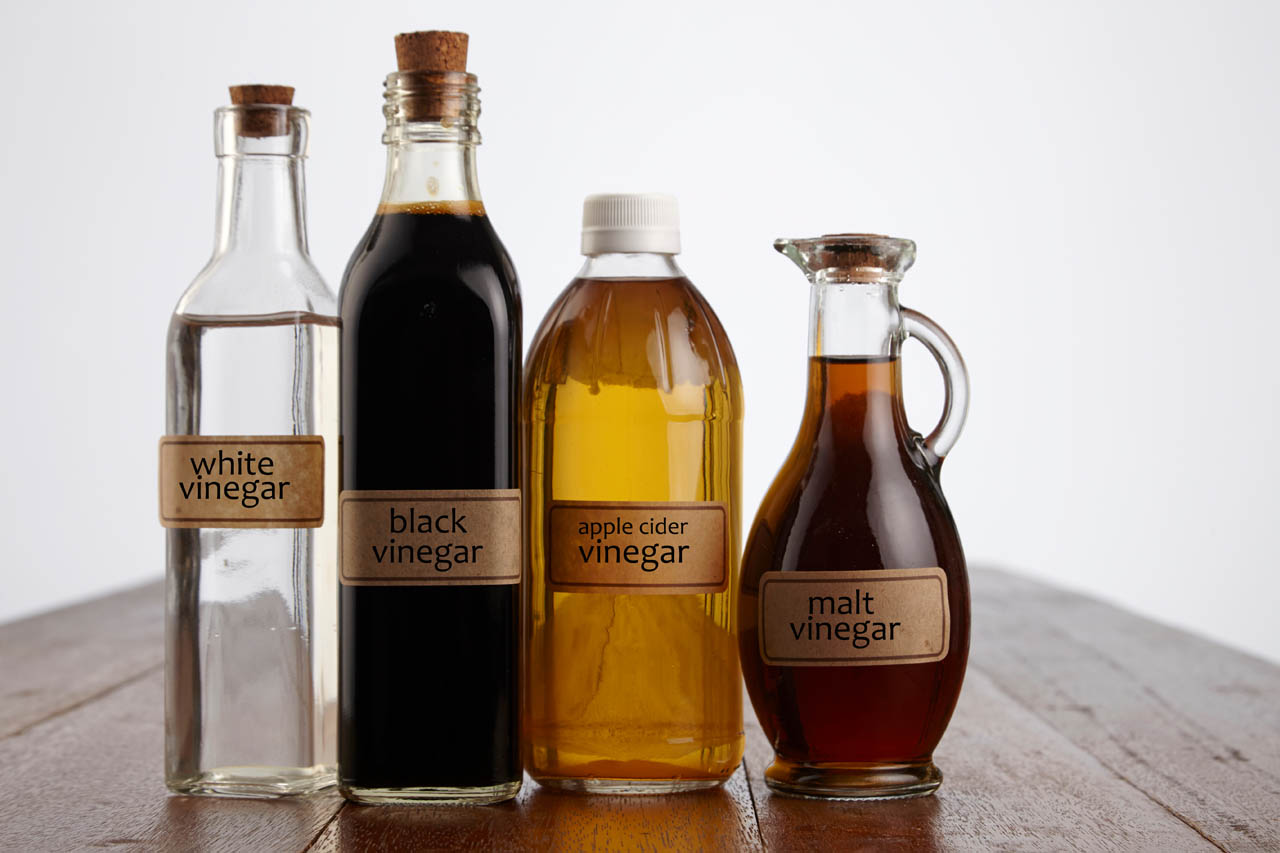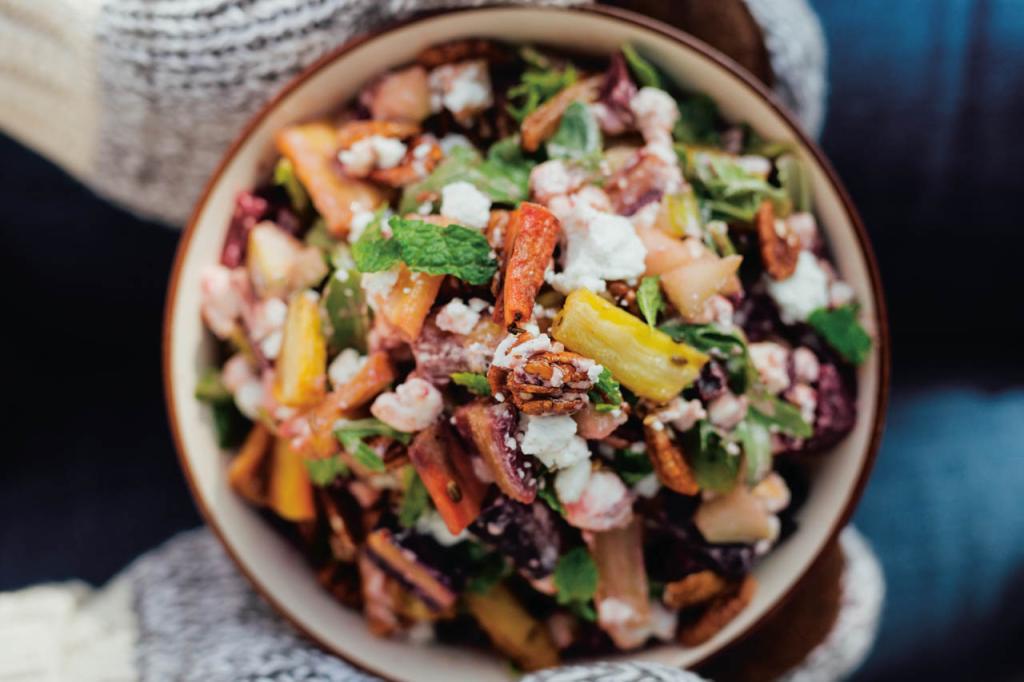
Vinegar is a pantry paradox for many home chefs – always present but often underutilized. If you only dust off that bottle of balsamic when making vinaigrettes, you’re overlooking one of the most versatile ingredients in your cooking arsenal. Vinegar can bring brightness to rich dishes, boost sweet and savoury flavours or add a finishing touch that ties all the elements of your dish together.
Different vinegars work different kinds of magic in your kitchen, however, with each type offering a distinctive flavour profile and culinary purpose. From bold and tart to soft and sweet, here’s a breakdown of some of the most common types of vinegar and how to use them to take your meals to the next level.

Get the recipe: A Feel-Good Fall Salad From Mandy’s
Apple cider vinegar
The apple of the wellness world’s eye, apple cider vinegar has gained popularity in recent years for its wide range of uses, which span from strengthening hair to potentially lowering blood sugar. This vinegar’s apple base gives it a pleasantly zesty, fruity taste. For culinary use, apple cider vinegar can cut through smoky flavours in BBQ sauces, or add zing to marinades and dressings. Its mild acidity also makes it an unexpected bar cart hero that can add a punch of flavour to cocktails and shrubs.
Rice vinegar
Made from fermented rice wine, rice vinegar – also known as rice wine vinegar – has a more rounded flavour profile and less tartness than most other types of vinegar. It comes in both ‘seasoned’ and ‘unseasoned’ varieties. ‘Seasoned’ rice vinegar is flavoured with sugar and salt, making it well-suited to perking up sushi rice or making fuss-free dipping sauces. ‘Unseasoned’ rice vinegar adds subtle sweetness to marinades, dressings or quick-pickled veggies.
Related: A Guide to Cooking Oils: Everything You Need to Know

Get the recipe: Easy Vegan Spaghetti Bolognese
Balsamic vinegar
While most vinegars belong to the supporting cast of ingredients in a dish, balsamic vinegar is the star of the show. Similar to Parmigiano-Reggiano cheese, traditional balsamic vinegar must be made in a specific region of Italy – either Reggio Emilia or Modena – and follow strict production guidelines. Much like wine, balsamic vinegar is made from grapes and aged in wooden barrels. The longer the vinegar is aged, the sweeter, thicker and more richly-coloured it becomes.
It’s worth investing in high-quality balsamic vinegar to bring depth to simple dishes like fresh fruit, charcuterie platters or burrata. The budget-friendly knock-offs you’ll see on grocery store shelves also have a place in your pantry, however. Although they don’t meet the same rigorous production standards as traditional balsamic vinegar, these bottles can be used to add new flavour dimensions to marinades, glazes and sauces.
Red and white wine vinegars
The flavour profiles of red and white wine vinegars are akin to their wine bases. Red wine vinegar’s tangy taste and full body makes it ideal for vinaigrette dressings or for lifting up the rich flavours of stews and braised meats. It should also be your go-to for pickling red onions.
White wine vinegar, on the other hand, has a mellower and brighter flavour than red. Use it in creamy sauces like Hollandaise, to create zingy dressings or for making deviled egg filling.
Sherry vinegar
Spain’s answer to Italy’s balsamic vinegar, sherry vinegar is made with fortified wine from a specific region in southern Spain and aged (for at least six months). Its price and flavour vary widely based on how long it has been aged as well as the quality of its sherry base. Shared regional origins make it a natural match for Mediterranean-inspired recipes, such as spicy stews or roasted veggie and meat dishes. Its delicately sweet, nutty flavour also makes it a tasty addition to creamy purees and dressings.
Malt vinegar
A staple on the condiment cart in British pubs, malt vinegar is made from germinated grains known as malt. Like its culinary cousin, beer, – which also uses malt in its production – malt vinegar pairs well with pub grub and fried foods. Malt vinegar’s toasty flavour has made it an iconic accompaniment to fish and chips. It’s also a popular seasoning for beans on toast, an equally beloved British dish. In addition, you can use malt vinegar to add soft caramel notes to glazes and marinades, or for making pub-style pickled onions.
Related: 6 Ways to Fix Over-Salted Food

Get the recipe: Anna Olson’s Red Velvet Cake
Distilled white vinegar
Distilled white vinegar is the vodka of vinegars, with its grain alcohol base giving it a clean, neutral taste. While this can initially make it seem like the blandest of the bunch, distilled white vinegar is useful for adding simple acidity to your dish without the flavour delivered by other types of vinegar. Keep distilled white vinegar at the ready for making a proper red velvet cake, flaky pie crusts, homemade buttermilk and ketchup, or for helping poached eggs congeal.
Other vinegars
Once you’ve mastered the use of these popular types of vinegar, you may want to experiment with more adventurous acids. Made from fermented grains, black vinegar, for example, is often used in Chinese, Korean and Taiwanese cooking. Coconut vinegar can add mild sweetness to curries and stir-fries. The world of wine vinegars extends beyond basic red and white to specialty varieties like champagne vinegar or cabernet sauvignon vinegar; while fruit vinegars like umeboshi (made from Japanese ume plums), raspberry, citrus can add a burst of orchard flavour to your meal in place of standard apple cider vinegar.
Read more: A Guide to Best Before and Expiry Dates in Canada
